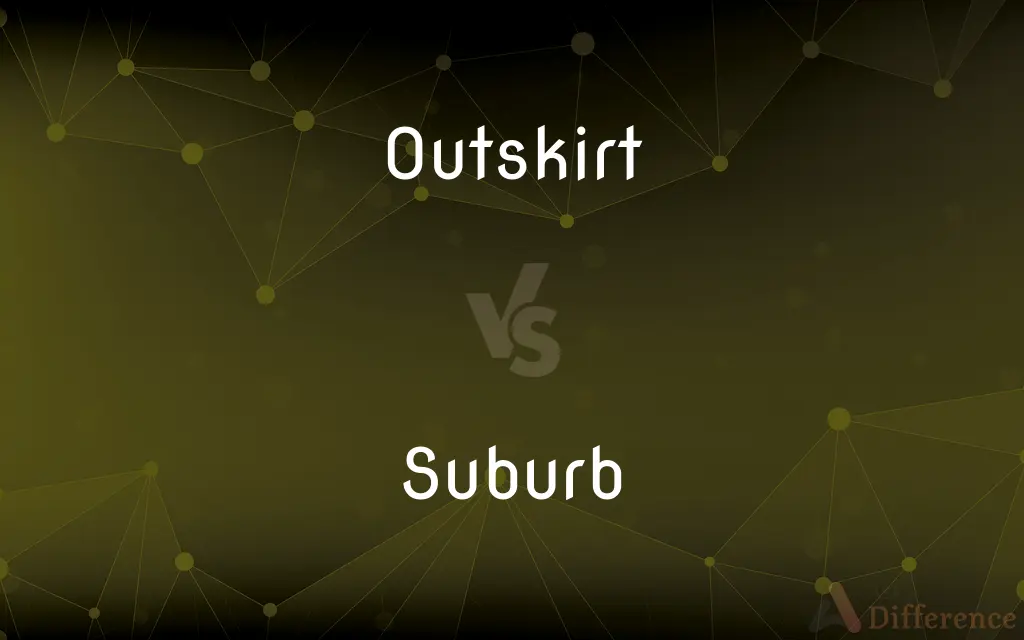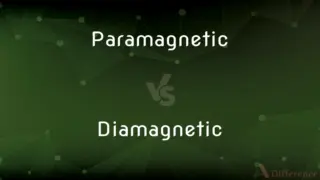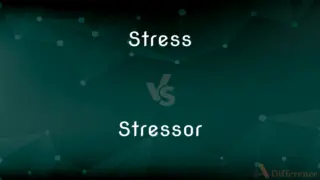Outskirt vs. Suburb — What's the Difference?
By Tayyaba Rehman & Maham Liaqat — Updated on April 4, 2024
Outskirts refer to the areas on the edge of a city or town, often blending urban and rural elements, while suburbs are residential areas near a city, typically with a higher degree of development and community infrastructure.

Difference Between Outskirt and Suburb
Table of Contents
ADVERTISEMENT
Key Differences
Outskirts represent the transitional areas between the urban center and the rural surroundings of a city or town. These areas are characterized by a mix of undeveloped land, industrial sites, and some residential zones, often with less dense population and infrastructure compared to the city center. Suburbs, on the other hand, are specifically designed as residential areas that lie on the periphery of a city, offering a more organized community layout, complete with housing, schools, parks, and commercial centers. Suburbs are generally more populous and developed than outskirts, aiming to provide a balanced lifestyle with access to urban amenities while maintaining a quieter, less congested environment.
The distinction between outskirts and suburbs lies primarily in their development and function. Outskirts may contain elements of both rural and urban life, without the full range of services and infrastructure typically found in suburbs. Suburbs are planned and developed with the intention of creating cohesive communities that cater to families and individuals seeking the benefits of both city life and a more tranquil, suburban setting.
While outskirts are often seen as the boundary of urban development, suburbs represent an extension of the urban environment, deliberately created to combine the conveniences of city living with the advantages of more space and greenery. Suburbs can vary widely in terms of their layout, density, and the socioeconomic status of their residents, but they share a common goal of providing a high quality of life outside the urban core.
The term "outskirt" implies a location that is peripheral and possibly less integrated with the central urban area, often with varying degrees of accessibility to city amenities. Suburbs, however, are typically well-connected to the city through transportation networks, making them integral parts of the metropolitan area despite their peripheral location.
While both outskirts and suburbs serve as transitional zones between urban and rural areas, suburbs are specifically residential and more developed, with a focus on creating a community lifestyle that balances urban access with suburban comfort.
ADVERTISEMENT
Comparison Chart
Definition
Areas on the edge of a city, blending urban and rural elements.
Residential areas near a city, designed with infrastructure and community amenities.
Development
Less developed, with a mix of undeveloped land, industrial, and some residential areas.
Highly developed, with planned residential communities, schools, parks, and commercial centers.
Population
Generally less dense, with a mix of rural and urban characteristics.
More populous, catering to families and individuals seeking suburban living.
Infrastructure
Limited infrastructure and services compared to suburban areas.
Comprehensive infrastructure, including transportation, schools, and healthcare.
Lifestyle
Offers a blend of urban and rural living, often with less accessibility to city amenities.
Focuses on providing a balance between city conveniences and the comfort of a quieter, greener environment.
Compare with Definitions
Outskirt
Often less accessible to urban amenities.
Living on the outskirts means a longer commute to the city center.
Suburb
Residential areas near cities.
They moved to a suburb for its peaceful, family-friendly atmosphere.
Outskirt
Varied use of land.
The outskirts are a mix of small farms, warehouses, and undeveloped plots.
Suburb
Higher degree of development.
Suburban streets are lined with houses, gardens, and community facilities.
Outskirt
Less developed, transitional zones.
We drove through the outskirts, noticing sparse houses amid vast lands.
Suburb
Integral to metropolitan areas.
The suburbs around the city are well-connected by public transport.
Outskirt
Edge areas blending city and countryside.
The factory is located on the outskirts, where the city meets the fields.
Suburb
Designed for community living.
The suburb features parks, schools, and shopping centers close to homes.
Outskirt
Reflects the boundary of urban expansion.
The city's outskirts are slowly being developed into residential areas.
Suburb
Offers urban conveniences in a quieter setting.
Suburban living combines the convenience of city access with the benefits of more space and greenery.
Outskirt
The part or region remote from a central district, as of a city or town
The outskirts of Buenos Aires.
Suburb
A suburb (or suburban area or suburbia) is a mixed-use or residential area, existing either as part of a city/urban area, or as a separate residential community within commuting distance of one. Suburbs might have their own political or legal jurisdiction, especially in the United States, but this is not always the case, especially in the United Kingdom where most suburbs are located within the administrative boundaries of cities.
Outskirt
A more remote part of a town or city; the periphery, environs; a suburb.
Many people commute into the business district from the outskirts of town.
Suburb
An outlying district of a city, especially a residential one
A highly respectable suburb of Chicago
A working-class suburb
Life is much better in the suburbs
Outskirt
(transitive) To surround as an outskirt.
Suburb
A usually residential area or community outlying a city.
Outskirt
A part remote from the center, and near the outer edge; border; - usually in the plural; as, the outskirts of a town.
The outskirts of his march of mystery.
Suburb
Suburbs The usually residential region around a major city; the environs.
Outskirt
A part of the city far removed from the center;
They built a factory on the outskirts of the city
Suburb
A residential area located on the outskirts of a city or large town that usually includes businesses that cater to its residents; such as schools, grocery stores, shopping centers, restaurants, convenience stores, etc.
Suburb
(by extension) The outer part; the environment.
Suburb
Any subdivision of a conurbation, not necessarily on the periphery.
Suburb
An outlying part of a city or town; a smaller place immediately adjacent to a city; in the plural, the region which is on the confines of any city or large town; as, a house stands in the suburbs; a garden situated in the suburbs of Paris.
[London] could hardly have contained less than thirty or forty thousand souls within its walls; and the suburbs were very populous.
Suburb
Hence, the confines; the outer part; the environment.
The suburb of their straw-built citadel.
Suburb
A residential district located on the outskirts of a city
Common Curiosities
What type of lifestyle is associated with living in a suburb?
Suburban living is often sought for its balance of urban convenience with the benefits of more space, quieter surroundings, and community-oriented lifestyle.
What distinguishes outskirts from suburbs?
Outskirts are less developed, transitional areas at a city's edge, while suburbs are residential zones designed with community infrastructure and amenities.
Can outskirts become suburbs?
Yes, as cities expand and develop, areas once considered outskirts can be developed into suburbs.
How do transportation options compare between outskirts and suburbs?
Suburbs typically have better transportation links to the city, including public transit, while outskirts may have less access to such amenities.
What factors might influence someone to choose living in the outskirts over a suburb?
Preferences for more open space, less development, or proximity to rural environments might lead someone to choose outskirts living.
Why are suburbs a popular choice for families?
Suburbs offer a conducive environment for family life, including safety, community amenities, and more living space.
Are outskirts considered part of the urban area?
Outskirts are on the urban-rural boundary, often with elements of both, but not fully integrated with the urban core's density or infrastructure.
How do schools in suburbs compare to those in city centers or outskirts?
Suburban schools often benefit from newer facilities and community support, contrasting with the varying conditions in city centers and the limited options in outskirts.
Do suburbs always have higher populations than outskirts?
Generally, suburbs are more populous due to their residential nature and developed infrastructure, unlike the more mixed-use, less dense outskirts.
What are the environmental impacts of suburban vs. outskirts development?
Suburban development can lead to more land consumption and habitat disruption, whereas outskirts may preserve more natural landscapes but risk becoming fragmented as development expands.
Share Your Discovery

Previous Comparison
Paramagnetic vs. Diamagnetic
Next Comparison
Stress vs. StressorAuthor Spotlight
Written by
Tayyaba RehmanTayyaba Rehman is a distinguished writer, currently serving as a primary contributor to askdifference.com. As a researcher in semantics and etymology, Tayyaba's passion for the complexity of languages and their distinctions has found a perfect home on the platform. Tayyaba delves into the intricacies of language, distinguishing between commonly confused words and phrases, thereby providing clarity for readers worldwide.
Co-written by
Maham Liaqat















































